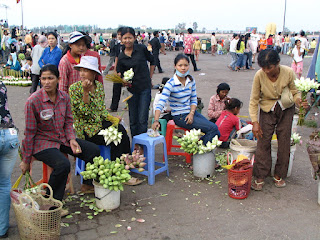2007-1-14 to 17
Phnom Penh was a much bigger city than Seam Reap. And it was a more interesting city. UNESCO office was across the street from the palace. The building was freshly painted and looked beautiful. Therefore, it must play a very important role in the country. Its pedestrian walk was as wide as the street or wider. Unfortunately, people used or blocked it. In this sense, Chinese had a much better control.
It was dry season, and we had good weather all the time.There was a temple called Wat Phnom built on a hill 27 m high. According to the legend, a woman name Pehn found four statues of Buddha deposited by the Mekong River during a flood. A pagoda was erected in 1373 to house these statues. And the city got his name of Phnom Penh (hill of Pehn).
The driver took us to the Russian market. I remembered that when we were in Dhaka in 1986, there was a big market where merchants from the East European countries came to buy clothing to be shipped back home. I didn’t know if this market was of the same nature, but there was no foreigners any more.
2007-1-14
The city was located at the confluence of the Mekong, the Bassac and the Tonle Sap rivers; and there was a wide Quay Karl Marx along the bank of the Tonle Sap. Next to the quay was the wide Samdech Sotharah Blvd where the Palace was located.
It was Sunday, and there were many people in the quay enjoying the nice weather. Many of them sit on mats laid on the quay or its grass and had picnic. There were many food and flowers peddlers and there were also peddlers for renting mats. There was a pavilion and beside it were two small temples, and one was crowded with worshipper while the other was quiet and empty.
There were many cages of swallows for sale. In some places the peddlers sold birds for the worshippers to buy and then freed them in a religious ceremony. However, the birds had been trained, and they would fly back to their nest in the peddler’s house. There were also many peddlers selling lotus flowers. They peeled some petals from the bud and fold other petals to make the flower look like in bloom. However, I didn’t see them being offered in the temple or in the river. We bought some lotus pods to eat its seeds. It tasted like young boiled peanuts, and it was bitter if the outside skin was not removed completely. We also bought a big pomelo. We had one before in Seam Reap and they were really good.
2007-1-15
We walked to the Palace in the morning. The ground was a square surround by high walls. We hired a guide, but she did not tell us much. There was a Chinese tour group and the guide was very good in explaining everything. Our guide tried to rush us through, and I showed her of my unhappiness. At the end she admitted that she had to go to the airport, and asked us to excuse her. I was mad and thought of not paying her. She ruined our day.
There were two main buildings in the palace ground. One was for receiving the senior mandarins; the other was more glamorous and was for receiving dignitaries. There was a rule that on each day of the week all people coming to this building must wear cloth of a certain colour. The building that attracted the tourists the most was the silver pagoda. Its floor was covered with over 5000 silver tiles, and it housed the Emerald Buddha and a life size Buddha made of solid gold and decorated with 9584 diamonds. There was an odd silver looking building which did not fit with others in the palace. It was a gift from Napoleon and was used for exhibition. The ground were surrounded by galleries decorated by paintings about the court life. Unfortunately, many of the paintings were damaged.
Like in Angkor Wat and other temples, there were two small white buildings in front of the main building; one was shown in 1723 and the other in 1607 and 1715. They are probably the libraries.
The residence part of the palace was surrounded by another walls and was not opened to public. Sihanuk was not there and he preferred to stay in China. His son was occupying the palace now.
We finished our visit at noon, and walked to a nearby Chinese restaurant for lunch.
2007-1-15
We didn’t have any photos about the art objects in the museum because it was not allowed to take any photos inside. It was a square building with exhibition halls on all four sides. Enclosed was a beautiful garden. It collected Khmer objects.
More photos can be seen by searching "lku99999, photo" in Google.
More photos can be seen by searching "lku99999, photo" in Google.








No comments:
Post a Comment